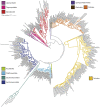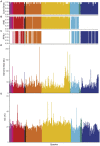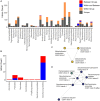Mitochondrial genome diversity across the subphylum Saccharomycotina
- PMID: 38075892
- PMCID: PMC10701893
- DOI: 10.3389/fmicb.2023.1268944
Mitochondrial genome diversity across the subphylum Saccharomycotina
Abstract
Introduction: Eukaryotic life depends on the functional elements encoded by both the nuclear genome and organellar genomes, such as those contained within the mitochondria. The content, size, and structure of the mitochondrial genome varies across organisms with potentially large implications for phenotypic variance and resulting evolutionary trajectories. Among yeasts in the subphylum Saccharomycotina, extensive differences have been observed in various species relative to the model yeast Saccharomyces cerevisiae, but mitochondrial genome sampling across many groups has been scarce, even as hundreds of nuclear genomes have become available.
Methods: By extracting mitochondrial assemblies from existing short-read genome sequence datasets, we have greatly expanded both the number of available genomes and the coverage across sparsely sampled clades.
Results: Comparison of 353 yeast mitochondrial genomes revealed that, while size and GC content were fairly consistent across species, those in the genera Metschnikowia and Saccharomyces trended larger, while several species in the order Saccharomycetales, which includes S. cerevisiae, exhibited lower GC content. Extreme examples for both size and GC content were scattered throughout the subphylum. All mitochondrial genomes shared a core set of protein-coding genes for Complexes III, IV, and V, but they varied in the presence or absence of mitochondrially-encoded canonical Complex I genes. We traced the loss of Complex I genes to a major event in the ancestor of the orders Saccharomycetales and Saccharomycodales, but we also observed several independent losses in the orders Phaffomycetales, Pichiales, and Dipodascales. In contrast to prior hypotheses based on smaller-scale datasets, comparison of evolutionary rates in protein-coding genes showed no bias towards elevated rates among aerobically fermenting (Crabtree/Warburg-positive) yeasts. Mitochondrial introns were widely distributed, but they were highly enriched in some groups. The majority of mitochondrial introns were poorly conserved within groups, but several were shared within groups, between groups, and even across taxonomic orders, which is consistent with horizontal gene transfer, likely involving homing endonucleases acting as selfish elements.
Discussion: As the number of available fungal nuclear genomes continues to expand, the methods described here to retrieve mitochondrial genome sequences from these datasets will prove invaluable to ensuring that studies of fungal mitochondrial genomes keep pace with their nuclear counterparts.
Keywords: diversity; evolution; mitochondria; selection; yeast.
Copyright © 2023 Wolters, LaBella, Opulente, Rokas and Hittinger.
Conflict of interest statement
AR is a scientific consultant for LifeMine Therapeutics, Inc. The remaining authors declare that the research was conducted in the absence of any commercial or financial relationships that could be construed as a potential conflict of interest. The author(s) declared that they were an editorial board member of Frontiers, at the time of submission. This had no impact on the peer review process and the final decision.
Figures






Update of
-
Mitochondrial Genome Diversity across the Subphylum Saccharomycotina.bioRxiv [Preprint]. 2023 Jul 31:2023.07.28.551029. doi: 10.1101/2023.07.28.551029. bioRxiv. 2023. Update in: Front Microbiol. 2023 Nov 23;14:1268944. doi: 10.3389/fmicb.2023.1268944. PMID: 37577532 Free PMC article. Updated. Preprint.
Similar articles
-
Mitochondrial Genome Diversity across the Subphylum Saccharomycotina.bioRxiv [Preprint]. 2023 Jul 31:2023.07.28.551029. doi: 10.1101/2023.07.28.551029. bioRxiv. 2023. Update in: Front Microbiol. 2023 Nov 23;14:1268944. doi: 10.3389/fmicb.2023.1268944. PMID: 37577532 Free PMC article. Updated. Preprint.
-
A genome-informed higher rank classification of the biotechnologically important fungal subphylum Saccharomycotina.Stud Mycol. 2023 Jun;105:1-22. doi: 10.3114/sim.2023.105.01. Epub 2023 May 25. Stud Mycol. 2023. PMID: 38895705 Free PMC article.
-
Genomic factors shaping codon usage across the Saccharomycotina subphylum.bioRxiv [Preprint]. 2024 May 24:2024.05.23.595506. doi: 10.1101/2024.05.23.595506. bioRxiv. 2024. Update in: G3 (Bethesda). 2024 Nov 6;14(11):jkae207. doi: 10.1093/g3journal/jkae207. PMID: 38826271 Free PMC article. Updated. Preprint.
-
Genome Diversity and Evolution in the Budding Yeasts (Saccharomycotina).Genetics. 2017 Jun;206(2):717-750. doi: 10.1534/genetics.116.199216. Genetics. 2017. PMID: 28592505 Free PMC article. Review.
-
Mitochondrial genome evolution in yeasts: an all-encompassing view.FEMS Yeast Res. 2015 Jun;15(4):fov023. doi: 10.1093/femsyr/fov023. Epub 2015 May 11. FEMS Yeast Res. 2015. PMID: 25969454 Review.
Cited by
-
Genomic factors shaping codon usage across the Saccharomycotina subphylum.G3 (Bethesda). 2024 Nov 6;14(11):jkae207. doi: 10.1093/g3journal/jkae207. G3 (Bethesda). 2024. PMID: 39213398 Free PMC article.
-
Genomic factors shape carbon and nitrogen metabolic niche breadth across Saccharomycotina yeasts.Science. 2024 Apr 26;384(6694):eadj4503. doi: 10.1126/science.adj4503. Epub 2024 Apr 26. Science. 2024. PMID: 38662846 Free PMC article.
-
Flow-cytometry reveals mitochondrial DNA accumulation in Saccharomyces cerevisiae cells during cell cycle arrest.Front Cell Dev Biol. 2024 Dec 16;12:1497652. doi: 10.3389/fcell.2024.1497652. eCollection 2024. Front Cell Dev Biol. 2024. PMID: 39737342 Free PMC article.
-
Characterization of the mitochondrial genomes for Ophiostomaips and related taxa from various geographic origins and related species: large intron-rich genomes and complex intron arrangements.IMA Fungus. 2025 Jul 22;16:e159349. doi: 10.3897/imafungus.16.159349. eCollection 2025. IMA Fungus. 2025. PMID: 40741210 Free PMC article.
-
An Alternative Self-Splicing Intron Lifecycle Revealed by Dynamic Intron Turnover in Epichloë Endophyte Mitochondrial Genomes.Mol Biol Evol. 2025 Apr 1;42(4):msaf076. doi: 10.1093/molbev/msaf076. Mol Biol Evol. 2025. PMID: 40172118 Free PMC article.
References
Associated data
Grants and funding
LinkOut - more resources
Full Text Sources
Research Materials
Miscellaneous

